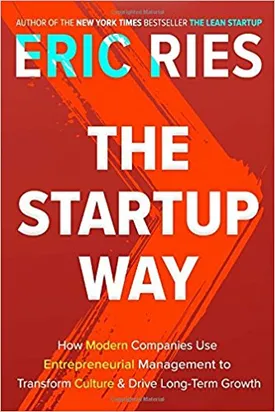The Startup Way by Eric Ries
Eric Ries’s bestseller, The Lean Startup, has revolutionized the way entrepreneurs think and approach building an efficient and successful business. The Lean Startup method outlines strategies to reduce waste, gain customer insights, and monetize product development efforts by encouraging experimentation and constant iteration. Now, in The Startup Way, Ries focuses on the application of the startup process on organizations of all sizes, from small scale startups to multinational corporations.
In The Startup Way, Ries argues that organizations can become “true Learning Organizations” by pursuing the startup model of entrepreneurship. A “true Learning Organization” is one that places innovation and product development - that is, learning - at the center of their corporate strategy. This means embracing the idea of experimentation and failure, continuous iteration and customer feedback loops, and data-driven decision-making.
Ries argues that startup methodology isn’t just for young, agile organizations. It is applicable for larger, established firms as well. The Startup Way provides an overview of the three stages of startup growth: “vision, stakeholder alignment and experimentation.” Each stage is further broken down into actionable steps.
In the first stage, vision, Ries emphasizes the need to create a shared purpose around which stakeholders can align themselves. Whether it’s a business strategy or a mission, organizations need a central idea that serves as the foundation for everything else. It’s important to recognize that this idea may need to be iterated as the organization learns more about customer needs and develops new products.
The second stage, stakeholder alignment, involves aligning internal elements - such as processes, teams, and resources - in order to realize the organization’s vision. This is done by breaking down the vision into measurable goals. Setting up a feedback loop is key here - stakeholders need to be able to measure progress, adjust goals, and iterate accordingly.
The third stage, experimentation, is where organizations move beyond goal setting to actively pursuing the vision. It starts with customer discovery, which requires gathering customer data and feedback in order to create a product that meets customer needs. Next, organizations move on to product development and launch, using using data to decide what works and what doesn’t. Lastly, the organization must turn customer feedback into learning opportunities to improve the product or launch subsequent products.
Throughout the entire process, it’s important to build an innovation system - one that drives the organization towards a collective goal. The innovation system should be based on culture, infrastructure, and process. Above all, Ries emphasizes the importance of creating a culture of experimentation, learning, and continuous improvement.
At the end of the day, organizations are nothing without customers. This is why Ries looks to start-ups for examples of customer-driven strategy. By pursuing the startup way and creating a customer-centric culture, organizations can create an innovation system that will lead them to success.

